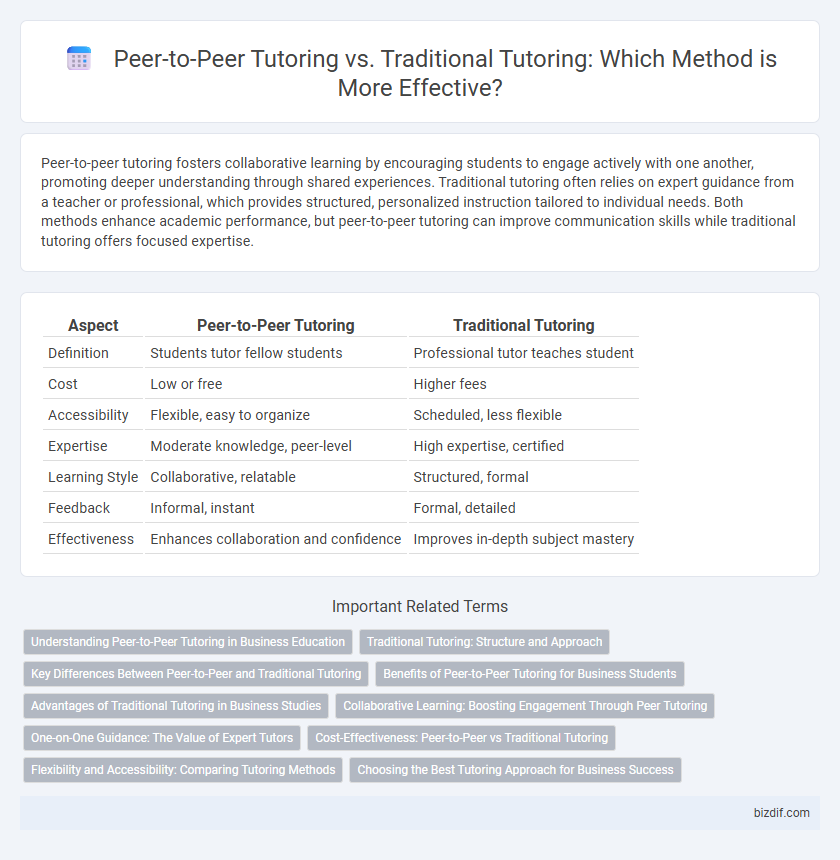Peer-to-peer tutoring fosters collaborative learning by encouraging students to engage actively with one another, promoting deeper understanding through shared experiences. Traditional tutoring often relies on expert guidance from a teacher or professional, which provides structured, personalized instruction tailored to individual needs. Both methods enhance academic performance, but peer-to-peer tutoring can improve communication skills while traditional tutoring offers focused expertise.
Table of Comparison
| Aspect | Peer-to-Peer Tutoring | Traditional Tutoring |
|---|---|---|
| Definition | Students tutor fellow students | Professional tutor teaches student |
| Cost | Low or free | Higher fees |
| Accessibility | Flexible, easy to organize | Scheduled, less flexible |
| Expertise | Moderate knowledge, peer-level | High expertise, certified |
| Learning Style | Collaborative, relatable | Structured, formal |
| Feedback | Informal, instant | Formal, detailed |
| Effectiveness | Enhances collaboration and confidence | Improves in-depth subject mastery |
Understanding Peer-to-Peer Tutoring in Business Education
Peer-to-peer tutoring in business education fosters collaborative learning, enabling students to exchange diverse perspectives on complex concepts such as finance, marketing, and management. This method enhances critical thinking and communication skills by encouraging active engagement and mutual problem-solving among peers. Unlike traditional tutoring, peer-to-peer approaches leverage shared experiences, promoting deeper comprehension and real-world application of business theories.
Traditional Tutoring: Structure and Approach
Traditional tutoring follows a structured curriculum designed by educational professionals, often emphasizing standardized testing and subject-specific mastery. Sessions are typically led by certified teachers or experienced tutors who utilize formal teaching methods, including direct instruction and systematic review. This approach ensures consistent progress through established learning goals, catering to the student's academic requirements with measurable outcomes.
Key Differences Between Peer-to-Peer and Traditional Tutoring
Peer-to-peer tutoring involves students of similar academic levels collaborating to enhance understanding, fostering a more relatable learning experience and promoting active engagement. Traditional tutoring typically features an expert tutor with specialized knowledge guiding the learner, often resulting in a more structured approach focused on curriculum mastery. Peer-to-peer methods encourage communication skills and mutual support, while traditional tutoring emphasizes personalized instruction and targeted academic improvement.
Benefits of Peer-to-Peer Tutoring for Business Students
Peer-to-peer tutoring enhances business students' learning by fostering collaborative problem-solving and real-world application of concepts, which traditional tutoring often lacks. This approach encourages active participation and improves communication skills, essential for leadership roles in business. Moreover, peer tutoring creates a supportive network that boosts motivation and retention of complex business strategies.
Advantages of Traditional Tutoring in Business Studies
Traditional tutoring in business studies offers personalized instruction tailored to individual learning styles, enhancing comprehension of complex concepts like financial analysis and marketing strategies. It provides structured curriculum support and expert guidance from experienced tutors with industry knowledge, ensuring relevant real-world application. Consistent feedback and progress tracking further reinforce mastery and academic confidence in challenging subjects.
Collaborative Learning: Boosting Engagement Through Peer Tutoring
Peer-to-peer tutoring enhances collaborative learning by fostering active engagement and mutual knowledge exchange among students, which often leads to higher retention rates compared to traditional one-on-one tutoring. This method encourages critical thinking and communication skills as learners explain concepts to peers in relatable terms. Studies show that collaborative environments created through peer tutoring increase motivation and improve academic performance by promoting a supportive and interactive learning atmosphere.
One-on-One Guidance: The Value of Expert Tutors
One-on-one guidance in traditional tutoring offers personalized instruction tailored to individual learning styles, enhancing comprehension and retention. Expert tutors bring specialized knowledge and experience that address specific academic challenges more effectively than peer-to-peer sessions. This individualized attention fosters deeper understanding and accelerates academic progress.
Cost-Effectiveness: Peer-to-Peer vs Traditional Tutoring
Peer-to-peer tutoring offers a significantly more cost-effective alternative compared to traditional tutoring by reducing hourly rates and eliminating expenses related to professional services. Students benefit from affordable access to customized support without sacrificing quality, making it accessible to a broader demographic. Traditional tutoring often involves higher fees due to credentials and institutional overhead, limiting its availability for many families.
Flexibility and Accessibility: Comparing Tutoring Methods
Peer-to-peer tutoring offers greater flexibility by allowing students to choose sessions that fit their schedules, often conducted virtually or in informal settings. Traditional tutoring usually involves fixed appointments with professional tutors in structured environments, which may limit accessibility for some learners. Increased flexibility and accessibility in peer-to-peer tutoring can enhance learning opportunities and accommodate diverse student needs more effectively.
Choosing the Best Tutoring Approach for Business Success
Peer-to-peer tutoring fosters collaborative learning and enhances communication skills, making it a cost-effective solution for businesses seeking scalable educational support. Traditional tutoring offers expert guidance and personalized instruction, ensuring high-quality knowledge transfer critical for specialized skill development. Selecting the ideal tutoring approach depends on organizational goals, learner needs, and budget constraints to maximize training outcomes and drive business growth.
peer-to-peer tutoring vs traditional tutoring Infographic

 bizdif.com
bizdif.com